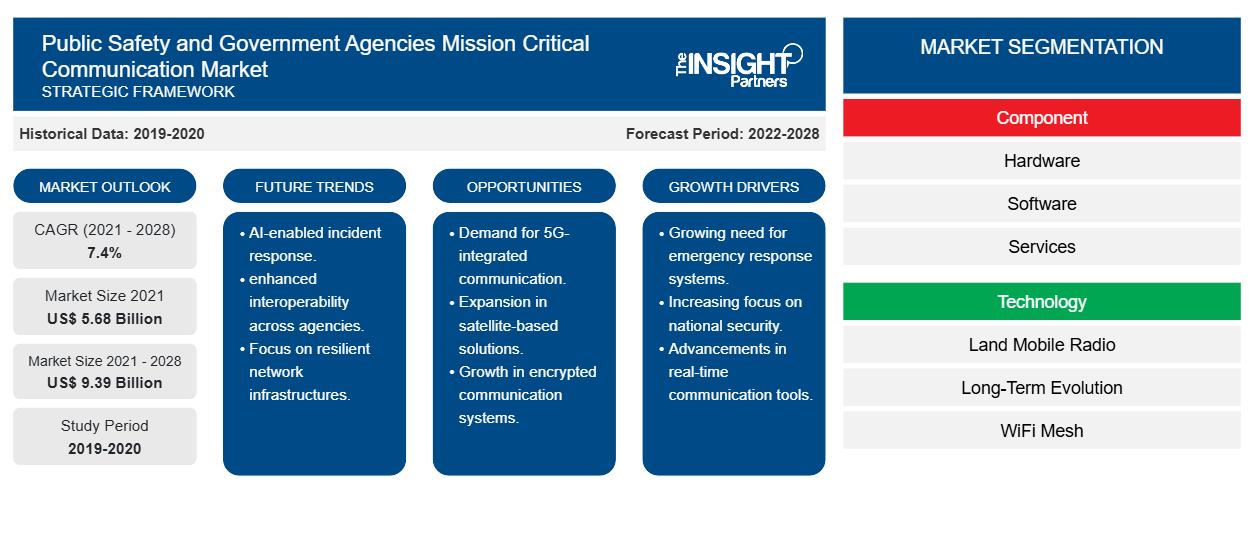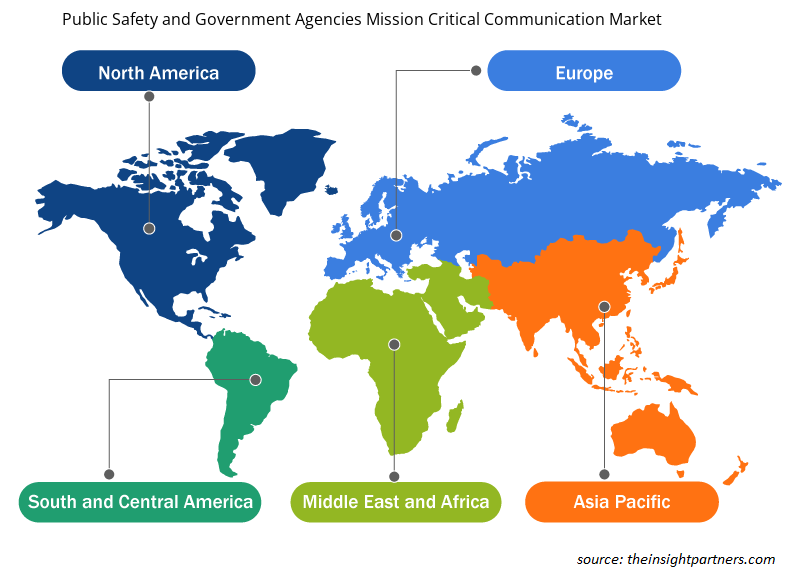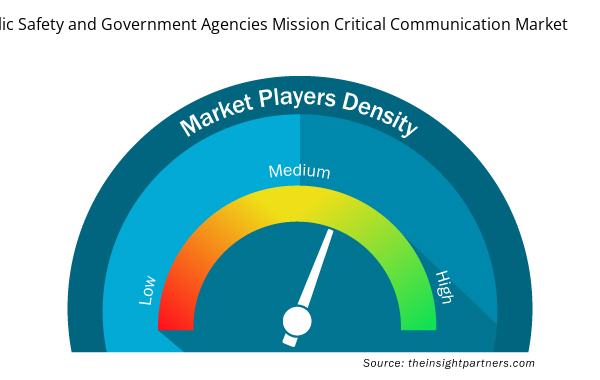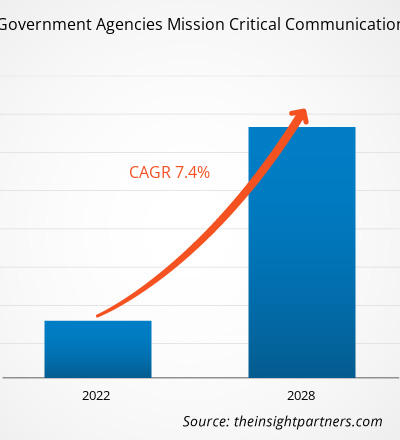Le marché des communications critiques pour la sécurité publique et les agences gouvernementales a été évalué à 5 684,3 millions USD en 2021 et devrait atteindre 9 390,0 millions USD d'ici 2028 ; il devrait croître à un TCAC de 7,4 % de 2021 à 2028.
Une communication critique implique des solutions qui facilitent les méthodes de communication avec les utilisateurs finaux dans des situations où les systèmes traditionnels ne parviennent pas à répondre à leurs demandes. En outre, le marché des communications critiques pour la sécurité publique et les agences gouvernementales facilite la communication et prend en charge les opérations qui présentent des dangers pour les personnes et les biens. Des appareils de communication cruciaux sont utilisés pour informer les gens sur les situations critiques. Sur le marché des communications critiques pour la sécurité publique et les agences gouvernementales , les opérateurs de réseau se concentrent sur de nouvelles stratégies de conception et de gestion des infrastructures de communication pour répondre à l'évolution rapide du réseau et des services afin de garantir un fonctionnement fiable du réseau.
Impact de la pandémie de COVID-19 sur le marché des communications critiques pour la sécurité publique et les agences gouvernementales
L'épidémie de COVID-19 a considérablement affecté le marché des communications critiques pour la sécurité publique et les agences gouvernementales en Amérique du Nord, entraînant des pertes financières substantielles pour les industries utilisatrices finales, les poussant à reporter encore davantage leurs plans de mise en œuvre du MCX. L'épidémie a également eu un impact sur les opérations des sites de fabrication de matériel de communication critique pour la sécurité publique et les agences gouvernementales, nécessitant un bref arrêt. En conséquence, plusieurs fournisseurs importants de composants et de technologies ont réduit leurs coûts et leur production. La demande d'électronique étant restée constante, cela a aidé le marché à reprendre sa croissance.
Personnalisez ce rapport en fonction de vos besoins
Vous bénéficierez d'une personnalisation gratuite de n'importe quel rapport, y compris de certaines parties de ce rapport, d'une analyse au niveau des pays, d'un pack de données Excel, ainsi que de superbes offres et réductions pour les start-ups et les universités.
Marché des communications critiques pour la sécurité publique et les agences gouvernementales : informations stratégiques

- Obtenez les principales tendances clés du marché de ce rapport.Cet échantillon GRATUIT comprendra une analyse de données, allant des tendances du marché aux estimations et prévisions.
Aperçu du marché
Demande croissante de diverses agences gouvernementales Propulsant la croissance du marché des communications critiques pour la sécurité publique et les agences gouvernementales
Les citoyens attendent des agences gouvernementales un service et une communication 24 heures sur 24. Ils souhaitent un accès facile à des informations correctes et actualisées et une connexion fluide avec les responsables gouvernementaux appropriés. Ils veulent également que les services soient fournis rapidement, efficacement et de manière transparente et que les problèmes soient résolus rapidement, efficacement et ouvertement. De nombreuses agences gouvernementales s'appuient encore sur des infrastructures de communication obsolètes, telles que des systèmes PBX loués ou des systèmes de type Centrex. En outre, sur le marché des communications essentielles à la sécurité publique et aux agences gouvernementales, les gouvernements développent et maintiennent d'excellents systèmes de communication pour être des acteurs respectables dans les sphères publiques. Les facteurs ci-dessus leur permettent d'évaluer les besoins et les préférences des résidents et de promouvoir une arène publique délibérative pour la participation de plusieurs parties prenantes, un débat politique éclairé et l'efficacité du développement d'urgence. Toutes ces questions stimulent la demande pour le marché des communications essentielles à la sécurité publique et aux agences gouvernementales.
Informations sur le marché basées sur les composants
Les composants matériels du marché des communications critiques pour la sécurité publique et les agences gouvernementales comprennent les centres de commandement et de contrôle, les routeurs et les passerelles, ainsi que les systèmes de gestion de la distribution. Le déploiement des composants matériels varie en fonction de la nature de l'agence de sécurité publique. Le nombre croissant de crimes signalés dans le monde entier stimule la demande pour le marché des communications critiques pour la sécurité publique et les agences gouvernementales.
Informations sur le marché basées sur la technologie
La radio mobile terrestre (LMR), également connue sous le nom de radio bidirectionnelle, est l'une des technologies de communication les plus utilisées sur le marché des communications critiques pour la sécurité publique et les agences gouvernementales. Cette technologie est continuellement testée et perfectionnée et est considérée comme une référence de réussite pour les communications critiques, en particulier dans le domaine de la sécurité publique.
Sur le marché des communications critiques pour la sécurité publique et les agences gouvernementales, le développement de produits est la stratégie couramment adoptée par les entreprises pour élargir leur portefeuille de produits, ce qui les aide à élargir leur clientèle et à maintenir leur nom de marque. Voici quelques-uns des développements clés récents sur le marché :
- En 2021, le gouvernement de la République d'Indonésie a déployé 500 appareils Iridium Push-to-Talk (PTT), achetés auprès d'Iridium Communications Inc., pour renforcer les opérations de communication dans tout le pays. Le gouvernement indonésien dispose désormais d'une solution de communication par satellite en temps réel fiable et « à emporter », adaptée aux communications en déplacement dans les nombreux paysages insulaires du pays.
- En 2021, Inmarsat a confirmé que BSNL, son partenaire stratégique en Inde, a obtenu les licences nécessaires pour fournir les services de haut débit mobile Global Xpress (GX) de classe mondiale d'Inmarsat. GX sera fourni aux clients indiens des secteurs public, aérien et maritime, dans le cadre de la licence Inflight and Maritime Connectivity (IFMC) de BSNL délivrée par le ministère des Télécommunications.
Aperçu régional du marché des communications essentielles pour la sécurité publique et les agences gouvernementales
Les tendances et facteurs régionaux influençant le marché des communications critiques pour la sécurité publique et les agences gouvernementales tout au long de la période de prévision ont été expliqués en détail par les analystes d’Insight Partners. Cette section traite également des segments et de la géographie du marché des communications critiques pour la sécurité publique et les agences gouvernementales en Amérique du Nord, en Europe, en Asie-Pacifique, au Moyen-Orient et en Afrique, ainsi qu’en Amérique du Sud et en Amérique centrale.

- Obtenez les données régionales spécifiques pour le marché des communications critiques pour la sécurité publique et les agences gouvernementales
Portée du rapport sur le marché des communications critiques pour la sécurité publique et les agences gouvernementales
| Attribut de rapport | Détails |
|---|---|
| Taille du marché en 2021 | 5,68 milliards de dollars américains |
| Taille du marché d'ici 2028 | 9,39 milliards de dollars américains |
| Taux de croissance annuel moyen mondial (2021-2028) | 7,4% |
| Données historiques | 2019-2020 |
| Période de prévision | 2022-2028 |
| Segments couverts | Par composant
|
| Régions et pays couverts | Amérique du Nord
|
| Leaders du marché et profils d'entreprises clés |
|
Densité des acteurs du marché des communications critiques pour la sécurité publique et les agences gouvernementales : comprendre son impact sur la dynamique des entreprises
Le marché des communications critiques pour la sécurité publique et les agences gouvernementales connaît une croissance rapide, tirée par la demande croissante des utilisateurs finaux en raison de facteurs tels que l'évolution des préférences des consommateurs, les avancées technologiques et une plus grande sensibilisation aux avantages du produit. À mesure que la demande augmente, les entreprises élargissent leurs offres, innovent pour répondre aux besoins des consommateurs et capitalisent sur les tendances émergentes, ce qui alimente davantage la croissance du marché.
La densité des acteurs du marché fait référence à la répartition des entreprises ou des sociétés opérant sur un marché ou un secteur particulier. Elle indique le nombre de concurrents (acteurs du marché) présents sur un marché donné par rapport à sa taille ou à sa valeur marchande totale.
Les principales entreprises opérant sur le marché des communications critiques pour la sécurité publique et les agences gouvernementales sont :
- Ascom Holding AG (Ascom)
- Globalstar
- Inmarsat Global Limited
- Iridium Communications Inc.
- nbn co ltée
Avis de non-responsabilité : les sociétés répertoriées ci-dessus ne sont pas classées dans un ordre particulier.

- Obtenez un aperçu des principaux acteurs du marché des communications critiques pour la sécurité publique et les agences gouvernementales
Segmentation du marché des communications critiques pour la sécurité publique et les agences gouvernementales :
Par composant
- Matériel
- Logiciel
Par technologie
- Evolution à long terme (LTE)
- Radio mobile terrestre (LMR)
- Maillage Wi-Fi
Profils d'entreprise
- Ascom Holding AG (Ascom)
- Globalstar
- Inmarsat Global Limited
- Iridium Communications Inc.
- nbn co ltée
- SES SA
- Télésat
- Société de télécommunications Thuraya
- AT&T Inc.
- SpaceX
- Analyse historique (2 ans), année de base, prévision (7 ans) avec TCAC
- Analyse PEST et SWO
- Taille du marché Valeur / Volume - Mondial, Régional, Pays
- Industrie et paysage concurrentiel
- Ensemble de données Excel



Report Coverage
Revenue forecast, Company Analysis, Industry landscape, Growth factors, and Trends

Segment Covered
This text is related
to segments covered.

Regional Scope
North America, Europe, Asia Pacific, Middle East & Africa, South & Central America

Country Scope
This text is related
to country scope.
Questions fréquemment posées
North America is known for placing a high value on public safety, with regional and national governments devoting large resources to the cause. For example, in 2020, the New York Police Department had a budget of $5.92 billion, the Los Angeles Police Department had a budget of $1.86 billion, the Chicago Police Department had a budget of $1.76 billion, the Philadelphia Police Department had a budget of $4.9 billion, and the Toronto Police Department had a budget of $1.22 billion.
In terms of market share, the market was dominated by the Long-Term Evolution (LTE) segment, which accounted for 49.7% of the total market share in 2020 and is expected to reach 47.8% of the market share by 2028. Long term evolution (LTE), commonly known as 4G (Fourth Generation) wireless standard, offers increased network capacity and speed for cellular communication devices. LTE offers up to 100 Mbps of download and 30 Mbps upload speed. One of the biggest advantages of using LTE in mission critical communication is data connectivity. Prior to LTE, the mission critical communication was majorly voice based with limited data usage. The introduction of LTE bought a wide range of applications, such as broadcasting or multi-casting, live streaming, and device-to-device communications in mission critical communication. LTE is capable of unify the existing mission critical networks based on disparate technologies, such as terrestrial trunked radio (TETRA), ultra high frequency (UHF), and very high frequency (VHF). Moreover, with the increasing use of connected devices such as drones and cameras by public safety agencies, the adoption of LTE for mission critical communication is expected to witness a significant growth during the forecast period.
A few key players operating in the public safety and government agencies mission critical communication (MCX) market are Ascom Holding AG (Ascom), Globalstar, Inmarsat Global Limited, Iridium Communications Inc., nbn co ltd., SES S.A., Telesat, Thuraya Telecommunications Company, AT&T Inc., and SPACEX, which are profiled in the report.
The global Public Safety and Government agencies mission critical communication (MCX) market was dominated by the hardware segment in 2020, which accounted for 49.1% of market share. The hardware segment is anticipated to continue its dominance during the forecast period as well. The mission critical communication is one of the prominent systems offering public safety agencies a dedicated communication platform. The hardware component of mission critical communication consists of command and control center, router and gateways, and distribution management system. The deployment of hardware component various and differs according to the nature of public safety agency. The growing number of criminal reporting across the world propels the demand for mission critical communications by public safety agencies worldwide, which drives the market growth for the hardware segment.
Many lives are lost as a result of natural calamities. Some losses could have been avoided if public agencies had offered timely information about the nature of the crisis and how to respond. For example, many lives could have been saved in Thailand in 2004 if PSAs had warned the people of the impending tidal wave. In addition, public warnings can be helpful in situations like terrorist attacks and other catastrophic events, such as the Fukushima Daichi nuclear power plant accident and the Tianjin port explosion. For this reason, public warnings share many characteristics of mission-critical communications. When properly hardened, commercial 3G and 4G networks can provide PSAs with performance and dependability superior to private radio networks. Government agencies can develop additional sites for increased redundancy, capacity, and coverage to raise backhaul bandwidth and improve physical security. The mobile network's resiliency and robustness will be increased due to this 'hardening,' such that in the case of a power outage or network infrastructure damage, the network can remain operational for a prolonged length of time. It is vital to guarantee that the standards for products and services that supply mission-critical communications are of the highest possible quality because there are scenarios where a service failure could have disastrous implications. Therefore, sufficient efforts are made to build resilient products. Mission-critical communications are not limited to a relatively small market, such as public safety, but rather that economies of scale are fully leveraged so that the additional development costs required to ensure the desired quality are shared across a more extensive user base.
The Public Safety and Government agencies mission critical communication (MCX) market is growing because of the global rise in terrorism, public safety, and desire for a reliable network during emergencies. However, the market's growth is hampered by high implementation costs, restricted data transit capabilities, and limited spectrum bandwidth. Government investments in mission-critical communication systems in the defense sector, on the other hand, are likely to generate attractive prospects for the industry in the coming years.
Trends and growth analysis reports related to Electronics and Semiconductor : READ MORE..
The List of Companies - Public Safety and Government Agencies Mission Critical Communication Market
- Ascom Holding AG (Ascom)
- Globalstar
- Inmarsat Global Limited
- Iridium Communications Inc.
- nbn co ltd.
- SES S.A.
- Telesat
- Thuraya Telecommunications Company
- AT&T Inc.
- SPACEX
The Insight Partners performs research in 4 major stages: Data Collection & Secondary Research, Primary Research, Data Analysis and Data Triangulation & Final Review.
- Data Collection and Secondary Research:
As a market research and consulting firm operating from a decade, we have published and advised several client across the globe. First step for any study will start with an assessment of currently available data and insights from existing reports. Further, historical and current market information is collected from Investor Presentations, Annual Reports, SEC Filings, etc., and other information related to company’s performance and market positioning are gathered from Paid Databases (Factiva, Hoovers, and Reuters) and various other publications available in public domain.
Several associations trade associates, technical forums, institutes, societies and organization are accessed to gain technical as well as market related insights through their publications such as research papers, blogs and press releases related to the studies are referred to get cues about the market. Further, white papers, journals, magazines, and other news articles published in last 3 years are scrutinized and analyzed to understand the current market trends.
- Primary Research:
The primarily interview analysis comprise of data obtained from industry participants interview and answers to survey questions gathered by in-house primary team.
For primary research, interviews are conducted with industry experts/CEOs/Marketing Managers/VPs/Subject Matter Experts from both demand and supply side to get a 360-degree view of the market. The primary team conducts several interviews based on the complexity of the markets to understand the various market trends and dynamics which makes research more credible and precise.
A typical research interview fulfils the following functions:
- Provides first-hand information on the market size, market trends, growth trends, competitive landscape, and outlook
- Validates and strengthens in-house secondary research findings
- Develops the analysis team’s expertise and market understanding
Primary research involves email interactions and telephone interviews for each market, category, segment, and sub-segment across geographies. The participants who typically take part in such a process include, but are not limited to:
- Industry participants: VPs, business development managers, market intelligence managers and national sales managers
- Outside experts: Valuation experts, research analysts and key opinion leaders specializing in the electronics and semiconductor industry.
Below is the breakup of our primary respondents by company, designation, and region:

Once we receive the confirmation from primary research sources or primary respondents, we finalize the base year market estimation and forecast the data as per the macroeconomic and microeconomic factors assessed during data collection.
- Data Analysis:
Once data is validated through both secondary as well as primary respondents, we finalize the market estimations by hypothesis formulation and factor analysis at regional and country level.
- Macro-Economic Factor Analysis:
We analyse macroeconomic indicators such the gross domestic product (GDP), increase in the demand for goods and services across industries, technological advancement, regional economic growth, governmental policies, the influence of COVID-19, PEST analysis, and other aspects. This analysis aids in setting benchmarks for various nations/regions and approximating market splits. Additionally, the general trend of the aforementioned components aid in determining the market's development possibilities.
- Country Level Data:
Various factors that are especially aligned to the country are taken into account to determine the market size for a certain area and country, including the presence of vendors, such as headquarters and offices, the country's GDP, demand patterns, and industry growth. To comprehend the market dynamics for the nation, a number of growth variables, inhibitors, application areas, and current market trends are researched. The aforementioned elements aid in determining the country's overall market's growth potential.
- Company Profile:
The “Table of Contents” is formulated by listing and analyzing more than 25 - 30 companies operating in the market ecosystem across geographies. However, we profile only 10 companies as a standard practice in our syndicate reports. These 10 companies comprise leading, emerging, and regional players. Nonetheless, our analysis is not restricted to the 10 listed companies, we also analyze other companies present in the market to develop a holistic view and understand the prevailing trends. The “Company Profiles” section in the report covers key facts, business description, products & services, financial information, SWOT analysis, and key developments. The financial information presented is extracted from the annual reports and official documents of the publicly listed companies. Upon collecting the information for the sections of respective companies, we verify them via various primary sources and then compile the data in respective company profiles. The company level information helps us in deriving the base number as well as in forecasting the market size.
- Developing Base Number:
Aggregation of sales statistics (2020-2022) and macro-economic factor, and other secondary and primary research insights are utilized to arrive at base number and related market shares for 2022. The data gaps are identified in this step and relevant market data is analyzed, collected from paid primary interviews or databases. On finalizing the base year market size, forecasts are developed on the basis of macro-economic, industry and market growth factors and company level analysis.
- Data Triangulation and Final Review:
The market findings and base year market size calculations are validated from supply as well as demand side. Demand side validations are based on macro-economic factor analysis and benchmarks for respective regions and countries. In case of supply side validations, revenues of major companies are estimated (in case not available) based on industry benchmark, approximate number of employees, product portfolio, and primary interviews revenues are gathered. Further revenue from target product/service segment is assessed to avoid overshooting of market statistics. In case of heavy deviations between supply and demand side values, all thes steps are repeated to achieve synchronization.
We follow an iterative model, wherein we share our research findings with Subject Matter Experts (SME’s) and Key Opinion Leaders (KOLs) until consensus view of the market is not formulated – this model negates any drastic deviation in the opinions of experts. Only validated and universally acceptable research findings are quoted in our reports.
We have important check points that we use to validate our research findings – which we call – data triangulation, where we validate the information, we generate from secondary sources with primary interviews and then we re-validate with our internal data bases and Subject matter experts. This comprehensive model enables us to deliver high quality, reliable data in shortest possible time.

 Obtenez un échantillon gratuit pour ce rapport
Obtenez un échantillon gratuit pour ce rapport